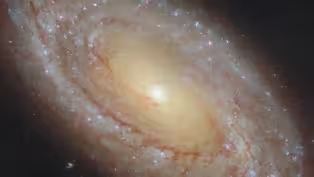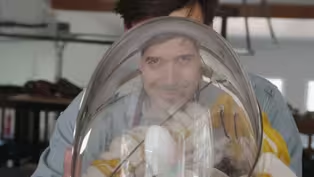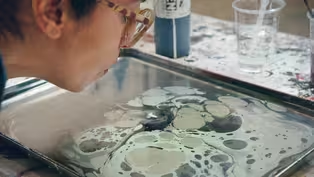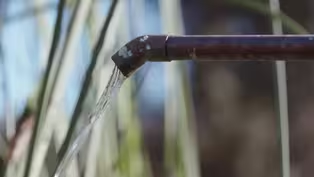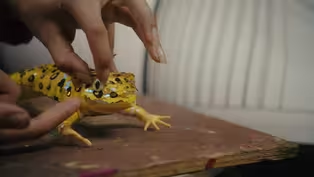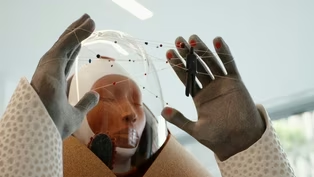
Art & Science Collide
10/17/2025 | 55m 11sVideo has Closed Captions
Meet a few of the featured artists from the Getty’s 2024 Southern California art event PST ART.
Weaving together stories of artists featured in the Getty’s 2024-25 Southern California art event Pacific Standard Time, the documentary showcases a sampling of the participating arts organizations and scientific institutions throughout the region.
Problems playing video? | Closed Captioning Feedback
Problems playing video? | Closed Captioning Feedback

Art & Science Collide
10/17/2025 | 55m 11sVideo has Closed Captions
Weaving together stories of artists featured in the Getty’s 2024-25 Southern California art event Pacific Standard Time, the documentary showcases a sampling of the participating arts organizations and scientific institutions throughout the region.
Problems playing video? | Closed Captioning Feedback
How to Watch Art & Science Collide
Art & Science Collide is available to stream on pbs.org and the free PBS App, available on iPhone, Apple TV, Android TV, Android smartphones, Amazon Fire TV, Amazon Fire Tablet, Roku, Samsung Smart TV, and Vizio.
Buy Now
Providing Support for PBS.org
Learn Moreabout PBS online sponsorship♪ Woman: I find this dividing of science and art incredibly problematic.
Man: We've divided science and art into categories of knowledge, but in reality, they're all one beautiful, complex system.
Woman: Artists and scientists have always, in many ways, been interested in the same issues.
How do we explore, explain, interpret, and represent the dazzling diversity of the universe?
We're still looking up at that night sky, trying to understand how do we fit into all of this?
[Music playing] ♪ Man: What as scientists do we learn from art?
It does remind us, I think, that the universe is itself spectacular.
It is in some sense art itself, right?
♪ Man: Art and science have been cast into these separate buckets.
This dichotomy, in a lot of circumstances, is a false one.
♪ Man: Until really the 18th and 19th centuries, there really wasn't a difference between artists and scientists.
Leonardo da Vinci is the example that everybody likes to point to.
A scientific lab and an artist's studio were often the same place.
♪ Woman: So with PST ART "Art & Science Collide," we really wanted to experiment with bringing together two communities that we discovered to be interested in very similar questions but that don't necessarily get thrown together too frequently.
♪ Man: At the end of the day, we're all just trying to figure this whole universe thing out, so that collaboration, bringing both the artists and scientists together to figure out this entire human experience, is the beauty of PST ART.
♪ Art is, above all, an essential communication strategy between humans.
Maybe the best one we have.
It's disarming.
It gets around our entrenched political defenses.
Woman: It can help us explore those issues, which now seem overwhelming for us.
In an era of climate change, of AI, of environmental racism, like, how do we find our place within all this?
And that's, I think, one of the most exciting signs I see coming out of this PST is people looking for solutions, for ways forward.
♪ Man: Well, welcome to the MTA, the Mojave Test Area of the Reaction Research Society.
-How's it going?
Dimitri.
-America.
-Nice to meet you.
-Nice to meet you.
Hi, America.
Frank.
We've met on the--online a couple of times on Zoom.
America: Yeah, yeah, yeah.
Good to see you in person.
Dimitri: Depending what you want for your background, We have some areas over there that might work out.
America: Yeah, we're leaning towards, like... the barren landscape backdrop.
Dimitri: OK.
America, voice-over: My project "The Monophobic Response" is a film project and sculpture work that frames the history of rocket science in Southern California through the lens of Octavia Butler.
I've been a fan of her writing as a science fiction author for a long time, and I started to think more about speculative fiction and science fiction as a way to imagine what other political realities are possible, and with Octavia Butler specifically, I knew that she grew up in Pasadena, California, where I grew up, around the same institutions like Jet Propulsion Laboratory and Caltech, and that just kind of made me think about what her relationship might be to the science community or rocket science.
♪ "Parable of the Sower" was written in 1993, and it's a projection of what the future could look like.
[Fire burning] ♪ Narrator: Saturday, July 31, 2027, morning.
Last night when I escaped from the neighborhood, it was burning, the houses, the trees, the people burning.
America: In "Parable of the Sower," the main character is this young black woman, and she's writing her own religion as a way to survive this period of extreme wealth inequality, extreme danger, and climate crisis and disaster.
Butler: The destiny of Earthseed, which is the name of her religion, is to take root among the stars.
Here my character is saying, "Not only is it "gonna be advancing us technologically, "it'll probably keep us from wiping each other out "here on Earth, and in the end, we'll go someplace else."
America: For the project, we created an accurate replica of this 1936 rocket test, and in my film, the Earthseed community is essentially doing that same test.
To me, that's really interesting because the Earthseed community, they aren't private tech billionaires.
Oftentimes when we see rocket science, it's primarily white men that are at the helm and deciding what the future is going to be for all of us, and I really wanted to, like, draw a contrast.
This sort of, like, ragtag group of black and brown people that don't have a lot of resources, and they have a similar desire to leave the planet to escape the climate crisis.
Dmitri: You're looking for more like where, like, Joel and Frank are standing, right?
America: Yeah, yeah, yeah.
Dimitri: That's the kind of surface you want to see?
America: Yeah.
Dimitri: OK.
Yeah.
-And also for Fire.
-Yeah.
Fire suppression, as well, yeah.
America, voice-over: I'm really interested in Octavia Butler's relationship to space exploration.
I think from how I can imagine it she was of two minds in terms of being sort of innately critical of the colonial impulse of the desire to travel into space and, you know, colonize a place like Mars, but at the same time, I think she was fascinated by it, and so having this ideological battle around what it means to venture into space is really sort of central to the project.
♪ Man: There is all of this oligarchical money moving towards escaping the planet and going into space.
Branson: Whoo!
Man: The concept I want to kind of, like, push forward is we're in space.
Like, this is it.
[Birds chirping] [Speaks Indigenous language] I'm Cannupa Hanska Luger.
I'm a enrolled citizen of the Mandan, Hidatsa, and Arikara tribes of North Dakota.
For PST, I'm making 3 figures wearing these suits that I've been calling Sovereignty suits.
All of the clay pieces that you see are the boots, gloves, and heads.
Here.
And the steel frame becomes the skeletal structure.
The Sovereignty suit is really me looking at NASA or cosmonauts, you know, anybody traveling into outer space, out of our atmosphere, and looking at what do we-- collectively as a species, what do we have to carry with us in order to be whole on the other side of any sort of travel?
I don't think, you know, your suit providing just air and water and shelter is enough for a people.
It's fine for an organism, but it's not enough for a culture, and so I'm trying to consider what it means to navigate through difficult or hostile environments and maintain yourself wholly.
The Sovereignty suit is kind of a response to that.
It's being informed by the technologies that we're using presently, but also, they're basically wearing a cabinet of cultural objects that are significant to the people who are carrying them.
♪ A sculpture is a time machine.
It is created in the present with information from the past to inform our future, and so these sculptures, I think, are time travelers.
♪ ♪ ♪ ♪ ♪ ♪ Man: The incredible act of having to sculpt every leaf on a tree--ha-- the act of taking an animal hide and stretching it over a sculpture to give it a lifelike pose.
Dioramas are a really amazing sculptural illusion, an infusion of art and science.
Museums traditionally displayed the specimens in their collection by having them laid out almost like a library.
They wanted to have these animals in an ordered way so that scientists can come and do research on the specimens... ♪ so at the turn of the 20th century, dioramas really were a revolution in how museums put animals and specimens on display.
♪ The early conservation movement that really spurns dioramas, this idea that these habitats are disappearing, we have to preserve them, was an important movement and was effective for many species... ♪ but people used to think that the best way to preserve these habitats was to go collect animals, collect plant life, and put them all behind glass.
♪ By modern standards, the idea of going out and mounting an expedition to collect animals might be questioned.
♪ In the past, museums, you know, were seen as an authoritative voice, and I think now our modern practice is to say, "We are part of this community, and we want community members to co-create with us here."
[Indistinct chatter] Man: A few years ago, I had this dream.
In that dream, the words "Special species" just kept repeating over and over and over again, and I always felt like I was meant to do something with this.
Special species are animals that are close to being endangered.
They're not yet protected, but they have a special concern for their ecosystems.
Woman: Since we're going to be in the Natural History Museum, we did specifically choose animals on the California Special Species list that can really hit home with the kids because it's really cool to think, like, "Oh, if they see that animal in the scene, they can also potentially see it in their backyard."
So I guess today, what do we want to accomplish?
If we think that we can... My name is Yesenia Prieto.
I'm a piñatera from Los Angeles, California.
Animals... A piñatera is someone that makes piñatas, so I was kind of born into this family business growing up, and since then, I've been trying to elevate it and not only just been making piñatas but installations and experiences, props, and other fun things like that.
When Jason reached out to me, he was like, "Oh, do you want to be a part of this project for the Natural History Museum?"
I was like, "Oh, my God, yes."
Chang: And then I told them about my dream, and then Yesenia was like, "Oh, wait.
"The founder of the alebrijes also had a dream exactly like that."
♪ Alebrijes are Mexican folk art spirit animals that are made from wood, usually painted with very intricate patterns.
♪ Prieto: Pedro Linares was a piñata maker from Mexico.
In 1936, he was on his deathbed and he had a fever dream.
♪ In this fever dream, he saw these fantastical creatures.
They were all whispering and chanting, "Alebrijes, alebrijes, alebrijes."
♪ When he woke up, he was, like, miraculously healed.
He attributed his healing to these animals.
Started painting them on wood and crafting them from wood.
It became a huge thing that's celebrated in Mexico.
This one's no good.
This one's good.
Chang: We're definitely not using the typical techniques of alebrije making.
Prieto: We're trying to represent alebrijes, but we're actually using piñata techniques.
One thing that's really interesting about the craft is that it's often overlooked.
A lot of the times, people will say stuff like, "Oh, like, why does this have value if it only lasts for 5 minutes?"
Or "Why is this an artform if you're just gonna break it?"
And what happens when things are overlooked, they can essentially be lost, and that's what's happening in the piñata world right now is that makers are giving up the craft or struggling with the craft, and the same thing can be seen with these species.
If you overlook them and you don't appreciate them, then what happens is they disappear.
And honestly, I think there's a lot of things that people might overlook in their regular life that makes you kind of realize things are really connected.
♪ ♪ Woman: It's not that Los Angeles doesn't have enough water.
It's that it's been mismanaged.
We know that the Los Angeles River shifted courses at least 9 times in the 19th century, and there were very dramatic shifts.
♪ The river is incredibly strong.
It's exceptionally dangerous.
Imagine the damage that kind of shift in current does, and so in 1938, there was a devastating flood... ♪ a lot of loss of property, loss of life... ♪ so the Army Corps of Engineers came in and channelized the river, and that's the river as we know it today.
It's concrete.
It's in a concrete jacket.
When it is raining, it does catch water and help avoid floods, but all of that water goes out to the Pacific.
So when you cover a lot of land in concrete, you're also removing the ability of that land to absorb the rain as it falls and to replenish the aquifer which is why California can continue to have these big rainy seasons but not be out of a drought.
♪ Woman: Hey, Antoine.
Antoine: Yeah?
Woman: Did you see the image that Nish made?
So I was thinking that probably it should go right here.
The architecture, yeah, the modularity.
Antoine: But, yeah, if you want... Bon: Metabolic Studio is a practice that has emerged from the work I do as an environmental artist.
We try and think about what we can do in the way of reparation, thinking about how did the place we live get to be like it is, and what can we do to help it function better as a living system?
♪ Woman: And Jenny kind of lives right there.
Bon: OK.
♪ "Concrete is Fluid" is a solo show dealing with the materials that have come into my hands as a result of "Bending the L.A.
River."
♪ [Train horn blowing] The project that helped me understand the L.A.
River was the trainyard that's actually right at the L.A.
River right next to Metabolic Studio.
That trainyard was placed there in the 19th century, and it only worked as a trainyard 9 months out of the year.
The rest of the time it was flooded, so they decided to move the trainyard to higher ground, but they left all of the dirty stuff that trains bring in in the ground, and it really compromised the health of that space.
That property had become a property of the California State Parks, and they were interested in cleaning it up.
I proposed that we start by growing corn on this site because corn can cleanse soil, so they said, "OK, we'll give you one agricultural cycle," and I said, "Great.
Where am I gonna get the water?"
And then I remembered all of those great parties from high school where people would go down to the L.A.
River because no one was ever down there, so I thought, "I'm gonna go down to the river "with a water truck, and I'll be able to grow corn, and I won't have to pay for it."
♪ And then I got caught.
The LADWP came down while I was filling up the water truck, said, "Uh, what are you doing?
"You do know that's illegal, right?
You can't just take water out of the L.A.
River."
And I'm like, "Why not?
Isn't it just going out to sea?"
And they say, "Yes, but it's not clean."
And I said, "Oh, don't worry about it "because we're testing it, and corn is a hyperaccumulator, "so not only can it clean the water, it can clean the soil"... and they said, "Well, you know, we can't let you "do this because even though it's a nice story, "we're still responsible for everybody's health, so we're gonna have to ask you to stop."
I thought, "Well, that's really silly, "and we should change that.
"We should make it so this water that's going out to sea can be used to clean up spaces that are dirty."
♪ What if you could keep the L.A.
River full of concrete for now because it's preventing floods and it's done it really well, but what if instead you could just punch a few holes into the side of that concrete and redirect the flow of the river so it could go back into those basins and let it reconnect with, say, the park?
♪ And they said, "Well, that's an interesting idea."
So they called the state park, and they said, "What's your annual water bill?"
And they said, "We're putting about $100,000 into irrigation," and they said, "Well, would it be good if you had free water instead?"
And they said, "Are you kidding?
That would be a deal changer."
So...they let me do it.
♪ And lo and behold, you had 32 acres of tiny, little corn sprouts growing on what was for 75 years just a greasy old yard.
♪ Woman: We think that what we see and hear and smell outside in the world is all there is, and actually, what we perceive of the world is just a vanishingly tiny sliver of what's out there.
♪ What these artists do is really awaken us to the fact that I don't end at my skin.
Let's consider what connects us to each other as human beings, but also let's consider what connects us to the animal world, the non-human world, the world of wind, the world of radio waves because, like I said, I don't end at my skin.
♪ Woman: There's something called aura microbiota, believe it or not, so even when I pass by you, we are mixing microbes.
Ha!
I want to add a bit more.
OK.
As a refugee from Iraq growing up in Sweden, my work is always about the outsider.
I want to think about the interconnectedness of...different species.
Go clear.
[Inhales] That's beautiful.
Wow!
Gorgeous.
Very molecular, no?
Cellular.
I'm really obsessed with microbes, seeing microbes everywhere... and thinking about microbes as allies, as part of us.
We know now that our human bodies are made out of a ratio of one to one human cells and microbial cells, so this whole notion of what makes you human is really untenable.
I'm constantly porous with the microbiota around me.
So in this obsession of thinking about how the microbes can become a vehicle to talk about, you know, dismantling differences, I started looking at the surface that I usually paint on, which is linen.
♪ Linen is made out of flax.
♪ There is a particular microbe that makes its way into the stalk of the flax plant and separates the stalk from the fibers, and this is how we naturally get flax fibers.
♪ So we have a microbe that helps us and aids us in making flax fibers.
♪ This is where I think art can contribute to us thinking more in terms of interconnectedness.
♪ The marbling for me is boundless.
♪ It really does look like you're looking through histological, biological tissue, yet at the same time, there is this macro vision in which you are looking at a larger cosmic universe.
♪ ♪ Dambrot: This edition of PST "Art & Science Collide" really speaks to what really the whole Southern California region is all about in that we've always been twin leaders in arts and entertainment and technology and outer space exploration.
Ferree: Early on, the development of aerospace technology was for defense.
I think here you have American Artist and a number of collaborators colliding these worlds together, and they reframe this and they say, "Well, what if the priority were more "in the interests of equality of those folks who weren't part of the original narrative?"
♪ It's an opportunity for us to think about where we want to go in the next hundred years.
♪ Man: So the founders of JPL started doing these rocket testings in October, October 31, 1936.
Their first test day, they only got one ignition.
They saw it sort of erupt, and they ran away and got no data.
So the second test day, November 15, they had modified the motor to use spark plugs to ignite it that time, and then they began actually succeed and get data and so on.
America: To create this project, I worked with rocket engineers.
I knew from the beginning that I wanted it to be a functional replica of this 1936 test.
♪ Man: We had a few drawings from archives.
We tried to reproduce it from what was basically a scale drawing of the cross section.
America: I think the biggest struggle is trying to imagine something that doesn't exist, and by that, I mean, like, what would it mean to re-create this rocket test, but sort of like imbue it with the sort of values Octavia Butler would have been thinking about?
You know, imagining this as kind of like one step that Earthseed would have taken that would have sort of paralleled the historical event of the JPL launch, but this is a new iteration.
Thinking about what are other reasons to want to explore space, what are other people that could even be able to inhabit and imagine themselves doing that.
[Rumbling] ♪ ♪ Luger: As advanced as we're supposed to be, we're still really just using fire.
Our whole electric grid, all of this sort of technology that's just extensions of the manipulation and control of fire.
These heads were the first I was gonna use for the Sovereignty suits, and the kiln reminded me of, um, where I failed.
I exploded 2 of the 3 heads.
The chin on this one peeled away.
You kind of become a detective in your own folly when you have these sorts of things, so, like, looking at this, I can see where I was bringing in the material for the chin, and I clearly left some bad connections.
Ha!
Everything you try to hide tends to come back in the crucible of the kiln and the honesty of 2,000 degrees.
That's Sitting bull.
He's an ancestor of mine on my father's side.
You know, he was a major leader in our communities.
I was born on the Standing Rock Reservation, where my dad's from.
I grew up, like, cattle ranching and watching science fiction.
Most of the sci-fi that I was really into was, like, desperate brutalization of one another in order for some sort of resource, but you're still dealing with, like, cowboys and Indians.
♪ The awareness that we've been removed from the land forcibly is ever present in every single highway mile marker, city limit sign, county line, aquifer.
Like, every single one of the things that we take for granted as Americans are threats to Indigenous people.
♪ So that's what I'm presenting here.
There'll be a figure here in this, -you know, Sovereignty suit... -Yeah.
surviving the hostility of the Hammer Museum, Los Angeles, North America, the United States, -whatever, you know.
-Yeah, yeah.
Figure there, figure there.
There's also a rover.
In the corner here will be one of my teepees, but it's gonna be made out of 3M highly reflective material, and so it's, like, high visibility, and the way it's gonna be presented is, like, half open, which makes a spaceship kind of shape.
-Yeah.
-This figure is gonna be either on this landing or at the very top, and what it's gonna be addressing is where we're interacting, and that's this span.
I want to use this wall as a window out into Los Angeles, where you see where we're at presently, but I want that to glitch and transform into a landscape that puts stars back in the Los Angeles sky and removes all of the architecture of dominance that we've kind of, like, established presently, you know.
If we're talking about a time-space continuum, is this an image of a post- or pre-Los Angeles, you know?
My thought is that these 3 figures are navigating space-time.
They are frozen in a moment, and that moment is far into the future, so us as audience are ghosts of their present.
♪ Even though the figures are large, they are within the realms of human possibility.
♪ When we are successful becoming in right relationship with the environment and we are no longer decimating plant life and natural environments, the likelihood of it becoming a more oxygen-rich planet is not unprecedented, and when there's more oxygen in the air, species tend to grow bigger.
♪ So these are normal-sized humans from a time-space where there's more oxygen in the air, thus visiting us here on this timeline, they must wear the environmental suit.
Each one is named after foods.
Food sovereignty foods, old foods that we had relationships with and developed ceremonies and cultural practices, knowledge around when to plant, when to harvest, and they're pretty-- they're pretty humble names, you know, in that sense, but I liked the idea of it--of it being that exchange, so this one's Squash.
This one right here is Squash.
♪ ♪ ♪ ♪ Kahraman: So the way I make flax, I choose a color and I...go like this and go this way and then this way and maybe one, two more times.
Then I grab my glue and water mixture.
I close this, and I wet the whole thing with a sponge, and then I go and hang it somewhere.
So I'll hang it here.
So... Weaving the flax is incredibly meditative.
It's not only therapeutic, but it feels like I'm creating my own world.
That's what it's about, really, is that I'm starting over, and there are infinite possibilities.
♪ So I was born in Baghdad.
I lived through two wars.
My mother decided to hire a smuggler, and we fled.
We finally reached our destination in Sweden, and that really marked, you know, a rupture for me, a rupture in who I thought I was.
♪ I was young, I was 10, 11, so I really wanted to become as Swedish as possible.
I bleached my hair.
I perfected the Swedish accent.
I erased everything that was part of my history.
I feel it.
I feel it in my body.
I feel the trauma and the pain.
I just don't remember.
♪ Many, many times I think to myself, "How can you heal when you don't remember?"
♪ So I'm very interested in migration, in dismantling border politics, and this is where this work also comes in.
How can I think with the porosity of our bodies, right?
How can I remove borders and think about how we leak into and through each other?
♪ There is no us and them, right?
There is no self and other.
There is no individual.
We are all really connected.
♪ ♪ ♪ Man: Every animal and every insect is extremely important.
Even if they're smaller, if one animal or one species becomes endangered, it can then affect or have a chain effect on a whole ecosystem over time, so we very consciously made the decision to make the perspective of insects larger than even, like, the wolf in the background to give them more representation.
♪ Prieto: Special species are not all on the endangered list, and that's why they're often overlooked because people think, "Oh, they're fine," and in reality, they are being affected by climate change or by their habitats being wrecked or honestly just not being paid much attention to.
♪ Those are the species that if we catch it now we can prevent them from being endangered.
♪ ♪ ♪ Woman: "Civilization is to groups "what intelligence is to individuals.
It is a means of combining the intelligence of many..." America: It was a really cool experience working with rocket scientists to create this.
As an artist, like, I just have a very different process, and they are very, like, technical and rigorous.
And I think it was interesting to be in conversation with them and to see them excited about the project, reading the novel in order to, like, understand the context and kind of building a relationship with them over a long time.
I think it aligns with what the Earthseed community would be doing because someone in that group would need to know how to make the rocket, and so just bringing together different fields of expertise to be able to create something like that.
3... 2... 1!
[Cheering] ♪ Luger: Dude, I'm in a post-apocalyptic world.
This is it.
This is what post-apocalypse looks like for Native people.
90% of my population was wiped out by disease, 90%.
I'm two generations into surviving the worst possible biblical aspect of, like, destruction.
From that space, let's talk about thriving.
♪ Can we get rid of the post-apocalyptic, violent future and collectively imagine what it means to be an extension of the land?
♪ Maybe that's the lesson that these time travelers come back to this moment to tell everybody.
♪ There is not a hole inside of you.
There is a hole inside of your environment, the shape of you.
♪ Can you fit back in?
♪ ♪ Prieto: I think we all have a deep connection to the Earth that maybe sometimes we don't show to other people, but it's there.
We're meant to connect.
♪ Kahraman: There's a term called refugia.
Refugia are pockets within habitats in which incredible destruction has hit... yet at the same time there is still life that blooms and that lives and that resists.
♪ That's what art reminds me of.
♪ The spirits that refuse to leave us.
♪ ♪ Bon: Sometimes, I think it's really good to think like an artist because you're thinking about an emblematic gesture.
Making a change in the flow of the L.A.
River hasn't been done before, but making it small enough that it didn't threaten the agencies that control it was the trick.
♪ We were able to cut into the river and lift that concrete up and look under it and see that, "Oh, my God!
There's another river under the river, and it's clean!"
♪ So there's a whole other world of water underneath the L.A.
River, and it's the groundwater that is alive and well and moving right down there.
♪ I think we think of concrete as so permanent, and in fact, healthy soil that's still buried beneath the concrete brought into our studio was immediately blooming again... ♪ which is incredible and so hopeful because we think that we've destroyed everything by paving over it or breaking the epistemological connection that Indigenous people have with earth and water and seed and atmosphere... but actually, all of that is just waiting for the opportunity to regenerate itself, so we don't kill the seeds or the bacterias that are in the ground underneath our roads.
We just put everything on ice until such a time that that is removed and sunlight and water hits the ground again, and then it has a powerful potential of rebirth and regeneration.
♪ Luger: We belong to this place.
It doesn't belong to us... ♪ and if we develop that sense of belonging, how would that radically change the way that we inhabit space?
How would that radically change the way we interact with one another?
And not just humans, but environment, animal, everything else.
I'm an optimist, and I believe in the inevitability of our equilibrium in nature and with nature.
♪ ♪ ♪ Weinstein: We're not looking to each individual artist to give us a solution, but they have a way of reframing issues for us, of raising new questions, of giving us bodily experiences of what those issues are, and sometimes, just sometimes, they are seers.
They often do point the way to the future, and we have to be the ones who are attentive to pick up on that.
♪ [Music playing] ♪ ♪
American Artist Reimagines Rocket Science via Octavia Butler
Video has Closed Captions
Clip: 10/17/2025 | 3m 58s | Reimagining rocket science through Octavia Butler’s vision of space and survival. (3m 58s)
Cannupa Hanska Luger's Time-Traveling Sculptures
Video has Closed Captions
Clip: 10/17/2025 | 2m 55s | Cannupa Hanska Luger’s Sovereignty Suits reimagine the spacesuit as more than survival gear. (2m 55s)
Hayv Kahraman on Interconnectedness Through Art
Video has Closed Captions
Clip: 10/17/2025 | 3m 37s | Artist Hayv Kahraman highlights human-microbe interconnectedness in her work. (3m 37s)
Lauren Bon Restores Urban Land with LA River Water
Video has Closed Captions
Clip: 10/17/2025 | 4m 54s | Urban restoration: Lauren Bon harnesses LA River to clean contaminated land. (4m 54s)
Special Species: Piñata Art Celebrates At-Risk Animals
Video has Closed Captions
Clip: 10/17/2025 | 3m 39s | Piñata-inspired art celebrates overlooked animals and endangered species. (3m 39s)
Video has Closed Captions
Preview: 10/17/2025 | 30s | Meet a few of the featured artists from the Getty’s 2024 Southern California art event PST ART. (30s)
Providing Support for PBS.org
Learn Moreabout PBS online sponsorshipSupport for PBS provided by:
